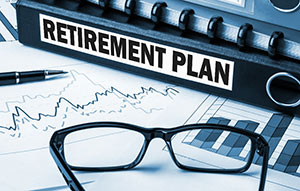 Building your nest egg is not an easy task, and managing your retirement funds can be stressful.
Building your nest egg is not an easy task, and managing your retirement funds can be stressful.
Americans, both young and old, struggle to save enough for retirement on top of daily life expenses. In fact, GoBankingRates asked three age groups - millennials, Generation Xers, and seniors - how much money they've managed to save for retirement. Their findings, published on March 14, were shocking...
According to the survey...
- 56% of Americans ranging from millennials to seniors have less than $10,000 saved for retirement
- One-third of Americans have no retirement savings at all
- About 75% of Americans over 40 are behind on saving for retirement
So why are so many people neglecting to save for retirement?
"People naturally tend to focus on the bills that are due today - and assume they'll have time to save for retirement later," said Cameron Huddleston, a money columnist for GoBankingRates on March 14.
Saving enough for retirement is tough and requires planning. That's why we're showing you five easy steps to increase your retirement funds over the next year.
We'll also be giving you skilled insight on how to manage your retirement portfolio from Money Morning Technical Trading Strategist, D.R. Barton, who has 28 years of experience helping investors master powerful trading techniques and profit from short-term stock trends like the professionals do.
Step 1 to Maximize Your Retirement Funds
D.R. Barton's first tip for investors who are falling behind on their investment goals:
Avoid the hype.
"Trying to find high-income plays when we are about to enter a rising interest rate environment is dangerous," Barton explained. "I believe that we are dropping from seeing the highest price we'll see for U.S. bonds for the next few years - maybe even for the next decade."
Indeed, the yield on the 10-year Treasury note closed at a 17-month high on Dec. 12.
But all of that could change since the Fed raised interest rates this week...
You see, when interest rates rise, bond prices go down.
"I fear that people who buy high-yielding stocks for the dividend or who buy junk (high-yield) bonds will suffer a similar fate - the value of the underlying asset dying much faster than other financial instruments," said Barton.
Besides, there are more solid avenues retirees can take to maximize their retirement funds...
Step 2 to Maximize Your Retirement Funds
Don't forget about Uncle Sam's requirements.
You must withdraw a minimum amount from your traditional 401(k) or traditional IRA account each year as soon as you are 70.5 years of age, except in certain special situations.
These withdrawals are called "required minimum distributions" (RMD).
Must See: This Great Depression-Era "Secret" Helped Transform Two Teachers into Millionaires. Read more...
You can always withdraw more than the minimum amount tax-free, but be sure to do so  before Dec. 31 - there are stiff penalties for missing the deadline. Particularly if you neglect to withdraw the RMD or withdraw less than the full amount. That sum is then liable for a 50% tax cut - in addition to the income tax due.
before Dec. 31 - there are stiff penalties for missing the deadline. Particularly if you neglect to withdraw the RMD or withdraw less than the full amount. That sum is then liable for a 50% tax cut - in addition to the income tax due.
To offset this tax fee, you can donate up to $100,000 to a qualifying charity from your account... if you have an Individual Retirement Account, or IRA. This donation can also be used to satisfy your minimum distribution requirement, according to U.S. News on Nov. 14.
Step 3 to Maximize Your Retirement Funds
One of the best things that you can do now to protect your money in the future is max out your retirement fund contributions.
The maximum that you can contribute to a 401(k) this year is $18,000. Of course, allocating such large sums isn't always an easy task to accomplish without curbing some spending or making other financial lifestyle changes.
Direct deposit into your retirement funds can be a simple way to achieve your goals.
"Adding to your nest egg every paycheck is an easy-to-implement strategy," said Barton.
When you opt for direct deposit, your contributions will be withheld from your paycheck before you ever have the chance to spend them - reducing the temptation to skip it.
Step 4 to Maximize Your Retirement Funds
When you're in need of funds, it can be tempting to dip into your 401(k).
Don't.
"Taking a 401(k) loan can significantly derail your long-term savings plan, and comes with plenty of financial penalties and potential tax consequences," said Catherine Golladay, vice president of 401(k) Participant Services at Charles Schwab, to GoBankingRates in February.
"Remember, this money is for your retirement, so leave it there until that day comes," she cautioned.
And once that day arrives, you'll want to make sure your retirement funds are indeed protected.
In this next tip, we give you expert insight on just how to do that...
[mmpazkzone name="in-story" network="9794" site="307044" id="137008" type="4"]
Step 5 to Maximize Your Retirement Funds
Beware of traditional methods of retirement saving.
"The old-school financial planning method of dividing your portfolio by putting a percentage amount equal to your age into bonds, and the rest into stock, is a potentially dangerous strategy now," said Barton. "[Like I said before] I believe we're heading into a multiyear bear market in bonds. So I certainly like a lower allocation into bonds than would be the traditional norm."
Urgent: An $80 billion cover-up? Feds use obscure loophole to threaten retirees... Read more...
Barton warned last year that as an investor, "taking a buy-and-hold approach with all of your retirement assets can be one of the biggest financial mistakes you make."
Here were his reasons why...
"Market pullbacks don't always come at convenient times," Barton wrote. "If you have funds tied up in a buy-and-hold strategy, and you need the funds during a huge drop in the market, you will be out of luck."
For example, inflation can eat away at your retirement. In order to produce stable returns that outperform inflation, you need a 60- to 70-year holding period, reported Crestmont Research in 2011. Additionally, you have a one-in-six chance of a negative return relative to inflation for each 20-year period.
Barton suggests diversifying your portfolio and supplementing "buy-and-holds" with more active strategies if you want to outperform the markets - even during an unexpected downward swing.
Editor's Note: D.R. Barton has helped hundreds of thousands master powerful trading techniques like swing trading, options, and cutting-edge risk management through Stealth Profits Trader. D.R. has over 26 years of experience identifying plays with the most potential for the largest, fastest gains. To subscribe to his valuable trading advice, click here.
Follow Money Morning on Twitter @moneymorning or Facebook.


